Reading Time: 7 minutes
If you’re on the hunt for an exciting, easy outdoor activity, then you need to learn how to go fishing for Bluegill. This species provides light tackle fun and smiling faces for anglers of all ages. It’s a great beginner fish for those of you starting out in your angling journey, while also offering multiple hookups and delicious treats.
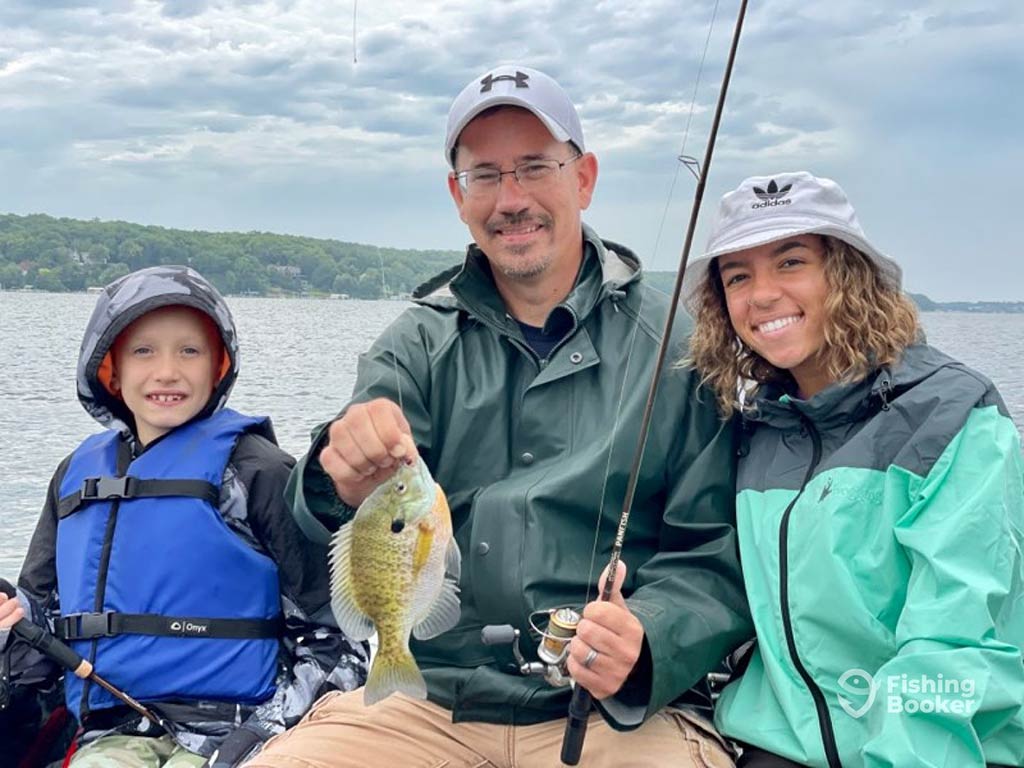
Photo courtesy of Tactical Angling
If you’re interested in a peaceful solo activity or one to include the family in, this is the fish for you. Keep reading to discover how you can successfully fish for Bluegill. I’m here to walk you through everything about this delightful species.
Bluegill Characteristics
A part of the Sunfish family, Bluegill are often also referred to as Panfish because they can fit in a frying pan. They’re also delicious, so it’s well worth taking your catch home with you! They’re obviously on the smaller size, reaching a maximum of 16 inches. On average, they weigh around 2 pounds, with bigger specimens reaching 5 pounds. But don’t let their small size fool you! These round fish are they fiery little critters. You’re sure to have a lot of fun battling it out with them on light tackle.
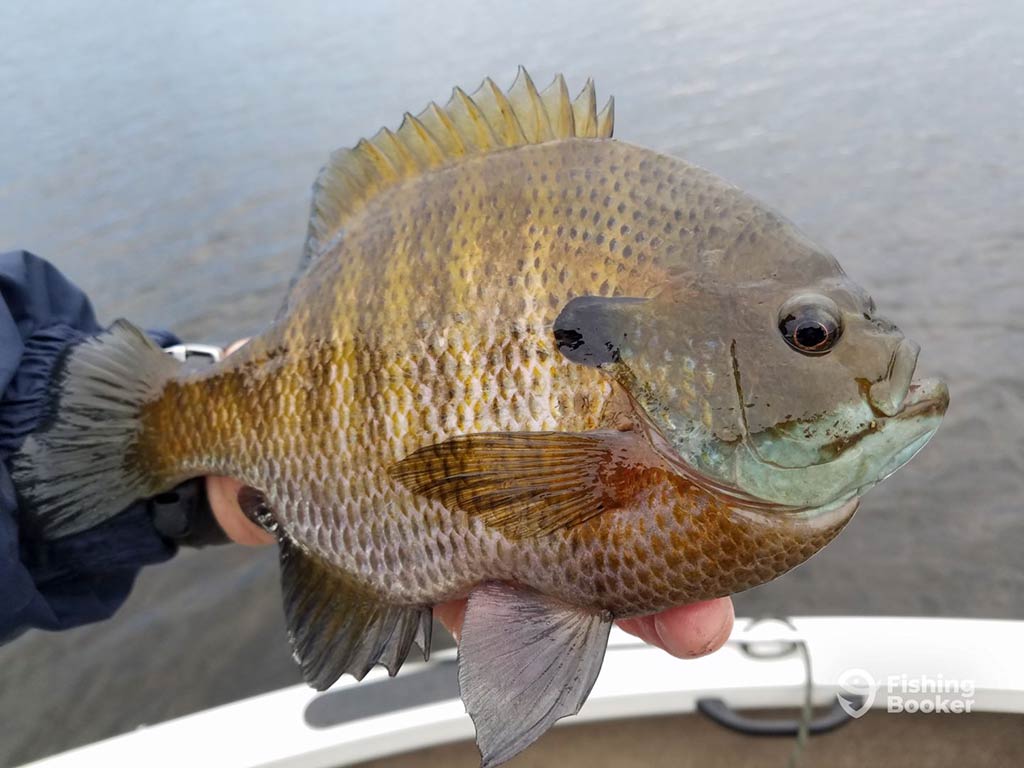
Photo courtesy of Slab Seeker Fishing Guide Service
When looking at Bluegill, you’ll notice a mix of colors such as brown, silver, gold, orange, and even hints of green. They’re often covered with a couple of vertical stripes, but these may or may not be visible. A solid black spot, which is actually their ear flap, is located right by their gill coverings.
For protection, they have a long, rigid dorsal fin that’s used to warn off and harm predators. As with other fish, additional fins help them maneuver throughout the water.
When to Go Bluegill Fishing
Bluegill are present many months throughout the year, mainly because they have long spawning periods. The most productive season to fish for them is spring or beginning of summer. During these months, they’re fired up the most as they’re on the hunt for food in preparation for the colder months.
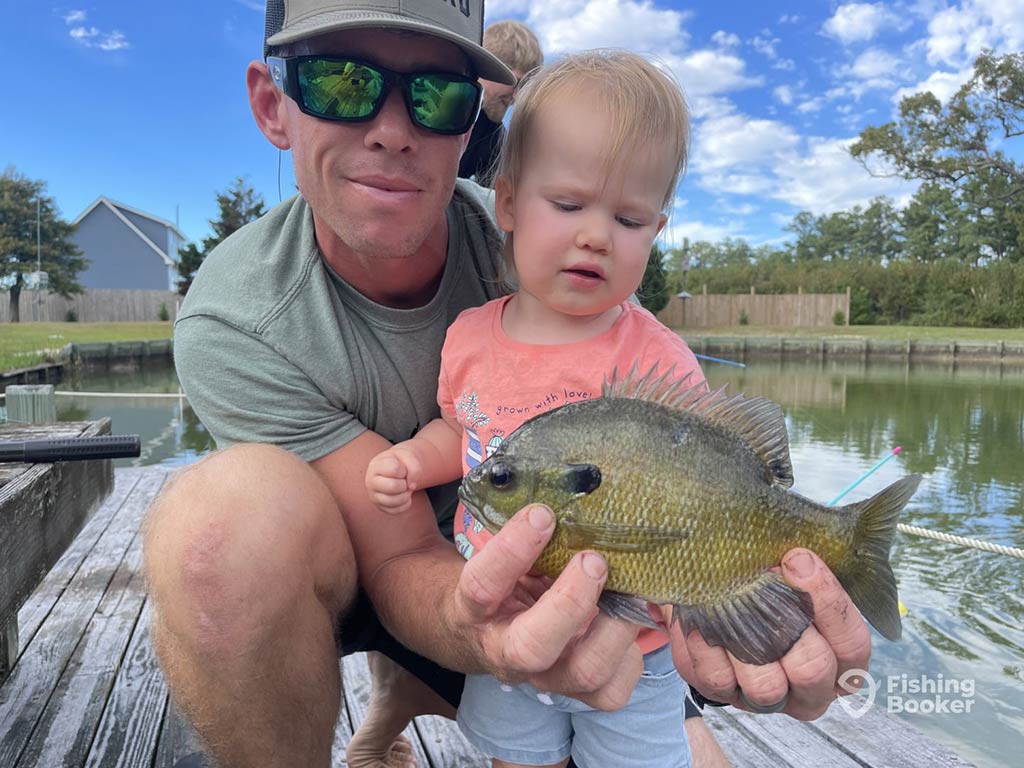
Photo courtesy of Avery’s Guide Service
When it comes to the time of day that produces the best Bluegill fishing, many anglers recommend early evening. Bluegill like to come out during midday to soak up the nice weather, and then tend to make a big appearance around the early evening. As the sun goes down, the water is more comfortable for the fish. Other species and bait are more active during lower light, too.
It’s best to fish for Bluegill during calm, warm, and sunny days. If it’s cold or rainy out, they tend to move to deeper water and sometimes don’t bite as much.
Where to Go Bluegill Fishing
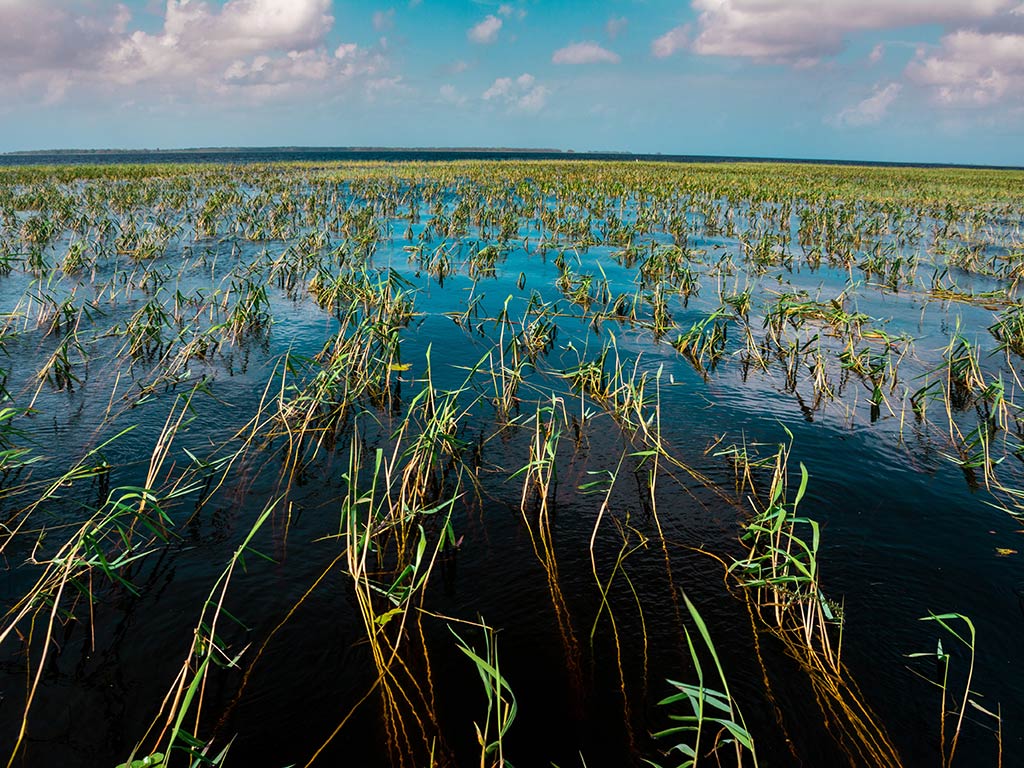
So you know when to go Bluegill fishing, now it’s time to discover some productive hunting grounds. You also know that Bluegill are freshwater fish, but you’ll want to cast around areas with a mixture of shallow and deep regions, along with structure hanging around. Look for any trees that hang into the water, lily pads, drop-offs near sandy shorelines, and, of course, Bluegill beds. Streams, canals, lakes, ponds, and rivers with shady areas, are all great locations.
A couple of well-known hotspots that boast plentiful Bluegill fishing opportunities include Lake Conroe in Texas, Lake Guntersville in Alabama, Reelfoot Lake in Tennessee, and Lakes Kissimmee and Okeechobee in Florida. There are tons of other hotspots across the country that give plenty of opportunities for Bluegill, and there are also many areas worldwide where they’ve been introduced. However, they’re considered invasive in most areas outside of the US.
How to Go Bluegill Fishing
So on top of the where and when, we have the how. First up, we have freelining live bait. This is the most common method used for Bluegill fishing and it’s when you let the bait do all the work. All you have to do is cast in a good spot and wait for the Bluegill to come to you. You can add a small sinker to keep them closer to the bottom, and some anglers also like to use bobbers to help identify when a fish has the bait.
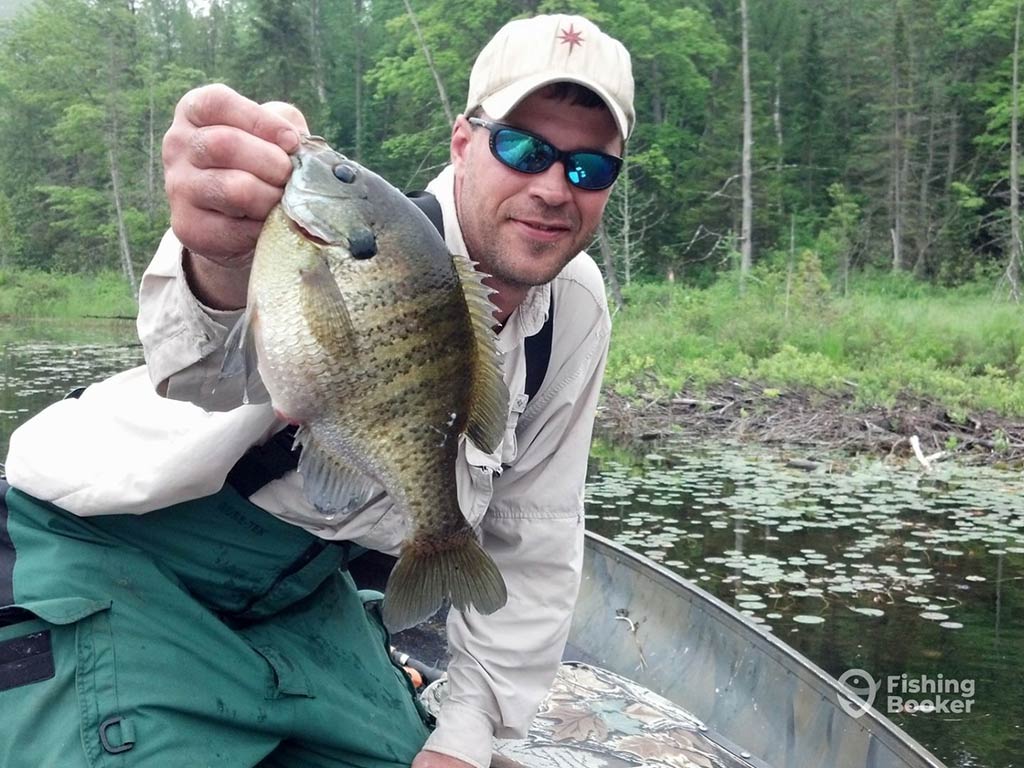
Photo courtesy of Northstar Fishing Adventures II
Following freelining live bait, we have artificial fishing. With artificials, one of the most popular methods is to bounce your bait along the bottom. Cast into an area with structure or fish beds and bounce your bait around. Once you get a bite, let it take it for a couple of seconds and then ensure a good hookset.
Lastly, we have fly fishing. With the use of a dark-colored wet fly, hungry Bluegill will be ready to lunge once it gets towards the bottom. If in a shallow region, you can use dry flies as well. Similar to the other methods, cast your fly into areas with lily pads or structures sticking out. This is where you’ll find greater quantities of Bluegill.
Whichever method you participate in, as long as you know the right areas to fish in, you already have a high chance of locating some Bluegill. Just remember to be patient and enjoy the peace of nature while you wait for a bite.
Best Bluegill Baits
Now that you know when, how, and where to fish for Bluegill, you need to know how to get them to bite. Bluegill eat a variety of live bait but have been known to hit artificial lures too. Let’s dive in and discover some of the most popular options.
Live Bait
- Worms are the most popular bait used for Bluegill fishing. They’re easy to find anduse. Plenty of stores sell worms for fishing and they aren’t too costly either. You also can dig up some in the dirt on your own! Popular worms include nightcrawlers, red worms, wax worms, and more.
- Crickets. These are unique baits! Bluegill sure love them, though. Similar to worms, you can purchase these guys at stores, online, or, if you can, collect them on your own.
- Snails. Many anglers in the mid-US are huge fans of snails for bait and have been using them for years. Snails are easy to use because you can find them just about anywhere. Bluegill enjoy them, but it’s better to use smaller ones to make sure you can get the hook in.
- Small fish such as minnows, shad, and shiners are perfect lively baits for Bluegill. Just make sure they are smaller and be aware other species other than Bluegill make try to eat them too.
Artificial Lures
- Soft plastics come in handy when trying to catch Bluegill without any live bait. They mimic the looks of prey and capture the attention of tons of fish –Bluegill included. A 1″ soft plastic paired with a 1/32 oz jig head is the perfect size.
- Plugs are good for getting the attention of many species. Their shininess, color, and sound entice Bluegill to eat. Choose ones around 1–2 inches, which are perfect for small-mouthed Bluegills.
- Jigs are another popular form of lure that works for Bluegill. With so many colors and styles to choose from, there are plenty of options. The main thing you want to pay attention to is size. Be sure to look for ones around the 1/32 ounce and 1 inch range to ensure it can fit into the mouth of a Bluegill.
If you have the option, choose live bait over artificial. But if all you have is artificial, don’t be discouraged as Bluegill are still attracted to them!
Recommended Gear for Bluegill Fishing
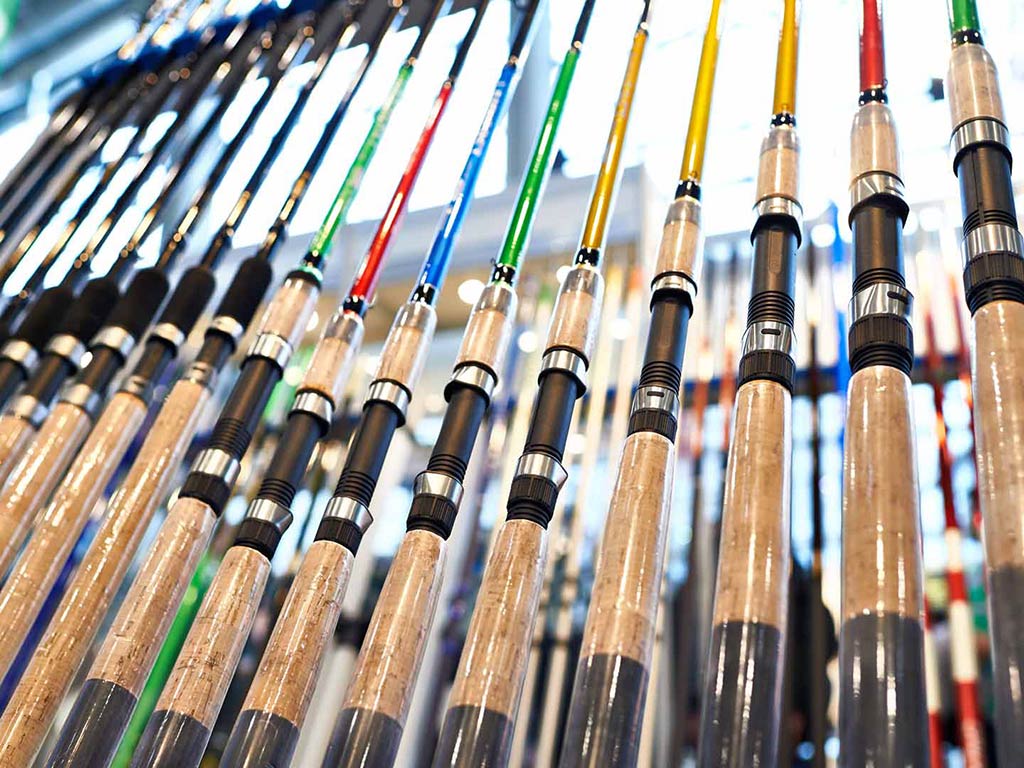
Following bait, we come onto your gear. Without your gear, you won’t be doing any fishing so it’s essential you have a good setup! As mentioned earlier, Bluegill are feisty but they’re pretty small, so the best setup will be anything that’s light or even ultra-light. This also will keep the feel of a good fight when bringing in your fish.
An example of a great Bluegill setup consists of an ultra-light rod and 1000 spinning reel, with a 4 lb braid and leader. You’ll also want a hook between the sizes of 6 and 8. No matter the equipment, fishing style, or preferences you have, everything should be very light.
Bluegill Fishing Regulations
As we reach our last section, I just need to talk about some regulations for Bluegill. After all, you want to make sure you’re fishing within the law! When you learn how to fish for Bluegill, you may be wondering is this a species you can take home too. Does it taste good? Well, here are the answers:

First, you must have a freshwater fishing license for your designated state before getting out there. You can purchase them online, by phone, or in person for a budget-friendly amount that will last you a while.
Next, it’s important to note that Bluegill are found all across the United States and in other areas of the world. With that, different regulations are put into place depending on the area. It’s best to visit your region’s Fish and Wildlife Conservation website to gather all the needed information.
To give you an example, I’ll use my state, Florida. You’re allowed to harvest 50 Panfish per day, including Bluegill. They aren’t too strict about this species so if you’re interested in harvesting in Florida, you can keep a bunch. As always, only keep what you need and release the rest.
Bluegill Fishing: A Peaceful Fishing Journey

Photo courtesy of The Hook Up Guide Service
Bluegill fishing is easy and fun. You don’t have to travel too far, you don’t need a bunch of expensive gear, and you can bring the whole family along. That sounds like a great fishing memory to me! Now it’s over to you to begin your angling journey…
If you have any great Bluegill fishing memories, share them in the comments below! We love hearing from you!
The post How to Go Bluegill Fishing: An Angler’s Guide appeared first on FishingBooker Blog.
https://fishingbooker.com/blog/bluegill-fishing/
 CampingSurvivalistHuntingFishingExploringHikingPrivacy PolicyTerms And Conditions
CampingSurvivalistHuntingFishingExploringHikingPrivacy PolicyTerms And Conditions
